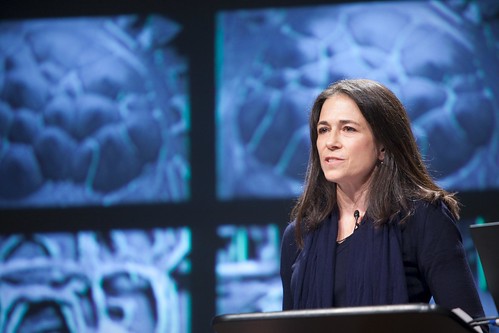I’m blogging from Camden, Maine, at the wonderful Pop!Tech conference. This year’s a special treat. My wife, the lovely Velveteen Rabbi, and I are team-blogging, trading off posts. You can read her posts on her website, or just read all of ours on the Pop!Tech site, where Michelle Riggen-Ransom has been doing brilliant work thus far. There’s lots of bloggers in the crowd and on twitter – follow the #poptech tag for lots of different perspectives.
Kyna Leski, an architect and art professor at RISD, gave her students a painting by Paul Klee – asked them to build a third dimension to the painting. One student assigned height to rectangles based on color, and built a complex object. He’d somehow osmotically absorbed the work of Klee and created an object that refracted the morning light to recreate the Klee painting.
The creative process makes me think that I am an atheist, and that I am not.
We become mystified by words like creative ability, talent or genius. These are different intelligences. Artistic sensibility is a keen intelectual perception. It’s on the cusp between percept and concept. It comes from the latin root that means “to gather”. I reckon, I get it, I gather, I see…

Kyna Leski, photo by Kris Krüg
If we’re asked to hold a sheet of paper, we grasp it between a thumb and forefinger. There’s a lot of intelligence in this simple gesture – we’re creating a cantilever and introducing dimension to the paper.
A medium is something that goes between and connections. When we choose materials and processes, they go between the questions that we’re asking. The friction in a thread and a magnet might capture the tension between living and working in a single space. These material geometries do not need translation. But metrics are needed to translate these things up in scale.
Finding, forming materials can be thought of as “material reasoning”. The word material comes from the word for mother, mater; the word for pattern from pater or father. Matrix comes from the word from womb. The matrix is where pattern and material are married. It is a generative order that holds the whole.
The sketch of a design for a chapel, starting with a church’s need to grow and breathe also starts with a trapezoidal footprint. We kept putting on a spire, and it kept getting knocked off. The word “spire” comes from spirit – inspire, spiral. We found that if we squared the walls to the trapezoidal plan, the building took on a spiral shape, looking as if the building is exhaling.
Creativity is not in knowledge, like we might get from a search engine – it’s about discovery, finding yourself somewhere in the unknown. The first studio class at RISD is designed to remove foundations, not put students on firm footing. Students look at cellular strucutres, to build a set of joints – critical for architects, the articulated meetings. Students make matrices which have distinct behaviors, a product of the articulation of the joints. In the process, they create a ground, or perhaps a raft, of their own, without room for previous baggage.
A creative work coheres by recognizing connections – coherence gathered and meaning made.
Leski’s notes for her talk are here – they are likely to be at least as helpful in understanding her ideas as my notes.